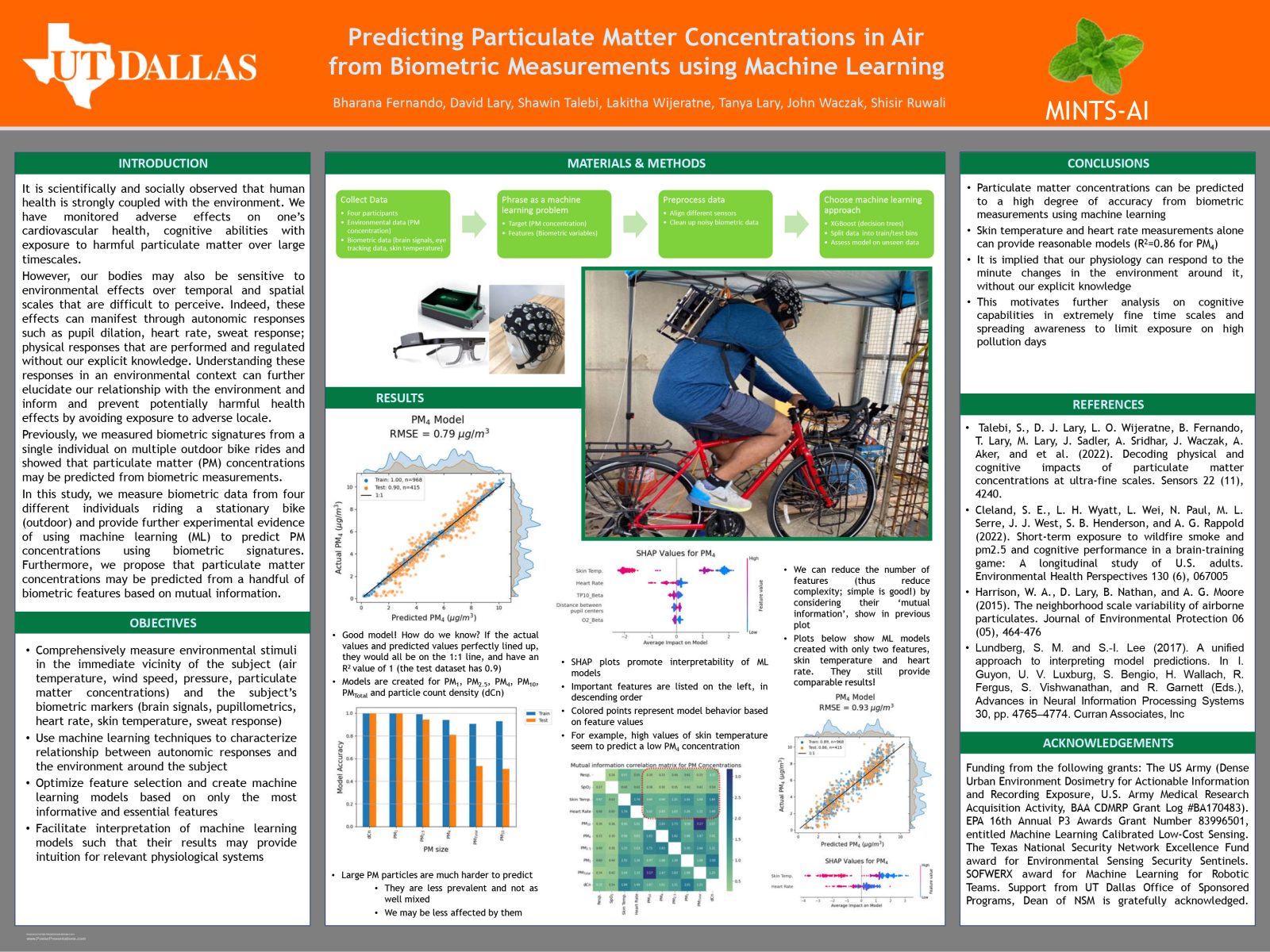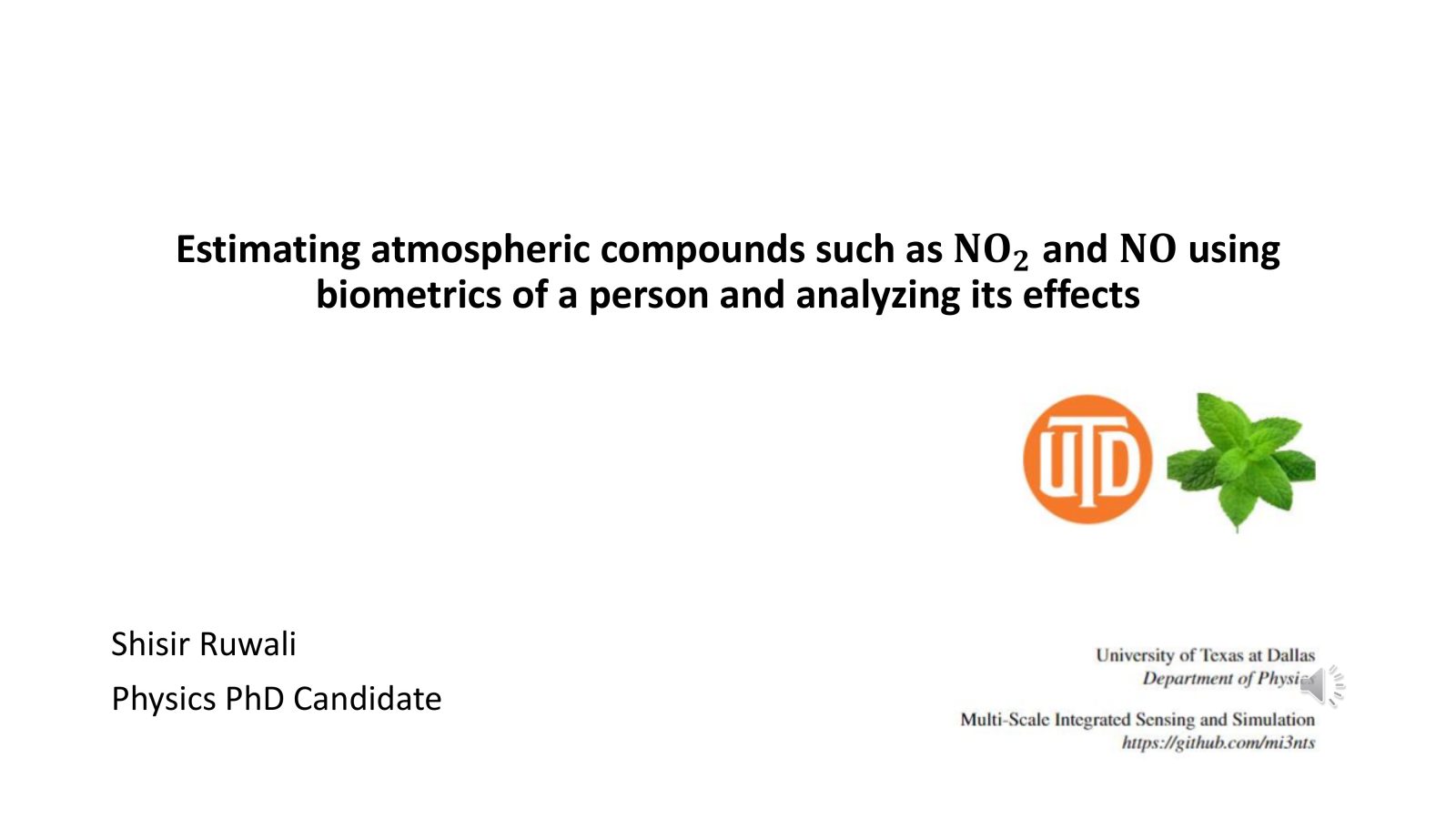For the upcoming UT Dallas Earth Week on April 14-22, 2023, join the Office of Research and Innovation and view the 2023 Earth Fair Poster Competition as nominated UTD graduate students showcase their Earth Fair posters. The following UTD graduate students will have a chance to be chosen as a winner of the 2023 Earth Fair Poster Competition.
2023 WINNER: Jayashree Balakumar

POSTER TITLE: Waste Disposition Management- An Enabler to Achieve SDG 3 within the Pharmaceutical Industry
POSTER ABSTRACT: Among many industries that generate waste, the pharmaceutical industry generates a significant amount of waste, including unused and expired drugs, contributing to environmental degradation. To support the third Environmental Sustainability Goal (Good Health and Well-being) and achieve environmental sustainability, new regulations are necessary to enable a strong reverse logistics program in the pharmaceutical industry. This paper critically analyzes the challenges and opportunities and proposes additional ANSI standards guidelines for effective disposition management programs for pharmaceutical waste. The study examines the current practices of the pharmaceutical industry in the United States vs. international practices in managing waste and the challenges of collecting, sorting, and disposing of/recycling pharmaceutical waste. It also investigates the role of regulatory frameworks in facilitating an effective disposition management program that can reduce the environmental impact of pharmaceutical waste. The paper provides a comprehensive overview of the legal, economic, and technological factors that influence the feasibility of implementing an effective disposition management program in promoting sustainable practices and achieving environmental sustainability. The study highlights the opportunities for developing new regulations that incentivize pharmaceutical companies to adopt sustainable practices and invest in infrastructure to support environmentally friendly waste disposal methods. The study also suggests a socially responsible framework for corporate enterprises and local governments to motivate good citizenship practices regarding safe pharmaceutical waste disposal. In summary, the study highlights the need for new regulations and additional ANSI standards as guidance for enabling a robust pharmaceutical waste disposition management program in the American pharmaceutical industry to achieve the third Environmental Sustainability Goal. Key Words: Pharmaceutical waste, New Regulations, disposition management, waste management, recycling
VIDEO LINK: https://youtu.be/nRo1-fZtIvk?t=2
Gokul Balagopal

POSTER TITLE: Characterizing the Temporal Variation of Airborne Particulate Matter using Variograms
POSTER ABSTRACT: Airborne particulates (aerosols) are criterion pollutants that have a wide range of negative impacts on human health. They can permeate deep into our bodies and can be the cause of respiratory diseases, cardiovascular diseases, and even cancer. Apart from this they also play an
important role in atmospheric radiative transfer and atmospheric chemistry, which in turn affects the climate and weather. Climate change and human health protection are the key challenges to maintaining. a sustainable environment. This study is based on the temporal variation of these airborne particulate concentrations in a neighborhood. As Environmental Agencies only report airborne particulate concentration once every hour, the sudden fluctuations in PM concentrations won’t be noticed. So, we use the Central Node which is a powered stationary sensor system comprising an array of sensors
developed in our lab. Every second, this system measures the various PM (Particulate Matter) levels. The data for this study comes from the Central Node located in Joppa, a neighborhood in Dallas where the PM levels are mostly above the WHO standards. The temporal variations are calculated for a day, a week, a month, and even up to a year. For an initial study, we are considering the fluctuation of PM concentration and count throughout the day.
VIDEO LINK: https://www.youtube.com/watch?v=j1Mdct6i1bs
Prashanth Boda

POSTER TITLE: Comet Composting Program at UT Dallas
POSTER ABSTRACT: Composting plays an important role to reduce greenhouse gas emissions in the atmosphere. Providing exposure and experience in composting to university students can go a long way in creating a responsible community. The University of Texas at Dallas (UTD) has implemented a composting program that includes pre-consumer and post-consumer food waste, providing an opportunity for students, staff, and faculty to compost on campus. This poster presents the outcomes and impact of the Comet Composting program, highlighting the importance of composting in promoting
sustainability and reducing waste.
VIDEO LINK: https://www.youtube.com/watch?v=L-zSZxx-Q3Q
Mohammed Eldeeb

POSTER TITLE: A novel approach for in-situ measurements of soil pH using an electrochemical sensor platform
POSTER ABSTRACT: Global warming, overpopulation, and animals going extinct are all effects of one major problem, lack of understanding and information of soil. Current methods of analyzing soil cost a lot of money and are done once every 2 to 5 years. This leads to over fertilization of soil which affects both marine life and plants as well. We have developed sensors that measure soil nutrients in real-time. They would send the data back to the farmers. This means that farmers always know the condition of their soil and can adjust accordingly.
VIDEO LINK: https://www.youtube.com/watch?v=MnOwYuqv_ug
Bharana Fernando

POSTER TITLE: Predicting Particulate Matter Concentrations in Air from Biometric Measurements using Machine Learning
POSTER ABSTRACT: It is scientifically and socially observed that human health is strongly coupled with the environment. We have monitored adverse effects on one’s cardiovascular health, cognitive abilities with exposure to harmful particulate matter over large timescales. However, our bodies may also be
sensitive to environmental effects over temporal and spatial scales that are difficult to perceive. Indeed, these effects can manifest through autonomic responses such as pupil dilation, heart rate, sweat response; physical responses that are performed and regulated without our explicit knowledge.
Understanding these responses in an environmental context can further elucidate our relationship with the environment and inform and prevent potentially harmful health effects by avoiding exposure to adverse locale. Previously, we measured biometric signatures from a single individual on multiple outdoor bike rides and showed that particulate matter (PM) concentrations may be predicted from biometric measurements. In this study, we measure biometric data from four different individuals riding a stationary bike (outdoor) and provide further experimental evidence of using machine learning (ML) to predict PM concentrations using biometric signatures. Furthermore, we propose that particulate matter concentrations may be predicted from a handful of biometric features based on mutual information.
VIDEO LINK: https://youtu.be/YmLeQGdD6FM
Miguel A. Guzman Hernandez

POSTER TITLE: Evaluating the Impacts of Sustainable Energy on Marine Life and Ecosystems
POSTER ABSTRACT: Renewable energy generation in the U.S. is projected to have a significant increase. Much of the demand for clean energy will come from offshore sources: such as offshore wind turbines, floating photovoltaics, and wave energy generators. The effects of large offshore power plants on the physical and biological processes are for the most part still unknown. In coupling of the FVCOM and our in-house UTD-WF LES codes, we can understand how renewable offshore energy affects underwater ocean circulation, and possibly identify optimal zones for seaweed farm co-location.
VIDEO LINK: https://www.youtube.com/watch?v=KHORotOEJ6U
Shisir Ruwali

POSTER TITLE: Estimating atmospheric compounds such as NO2 and NO using biometrics of a person
POSTER ABSTRACT: The air we breathe has plenty of effects in our body. Our body responses to environmental conditions. Some of these responses are brain signals, skin temperature, sweating etc. These biometric variables can be measured and using these data we can estimate constituents of the
atmosphere such as CO2,NO2,PM1 particles etc. by using Machine learning models. These machine learning models can also help in identifying the relation between biometric variables and the particles, compounds we measured. In the study we estimate NO2 and find out that one of the variable that is affected is the part the brain that is responsible for speech and audio recognition.
VIDEO LINK: https://www.youtube.com/watch?v=yaBrj4BWwaM
Gwen Schaulis

POSTER TITLE: Justice at the Heart of Environmentalism: Conversations Inspiring Community
POSTER ABSTRACT: Traditional approaches to environmentalism often fail to see the system at large. Let’s take a step back. The civil rights movement, women’s rights movement, environmental movement, and other mid-century revolutions are intertwined. They share a common goal: equal justice for all. In
the face of this unmet goal, a greater approach has been put forward. Intersectional environmentalism asserts that the issues we fight, both social and environmental, overlap and are experienced disproportionately across identities and privileges. Mainstream environmentalism is evolving from wilderness conservation projects to fighting land-use policies that endanger human lives. Younger populations are front-and-center climate activists, introducing intersectional environmentalism as the lens for understanding and achieving justice. College students benefit from safe educational spaces to think critically about the environment and understand the interdisciplinary nature of sustainability. Hear from an Eco Rep at UTD’s Office of Sustainability on how she created that space by facilitating an environmental justice book club and teach-in webinar.
VIDEO LINK: https://youtu.be/_OvuwwrUPOI

You must be logged in to post a comment.